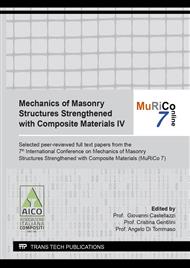p.27
p.35
p.43
p.50
p.58
p.66
p.74
p.82
p.91
Mechanical Behaviour of Glass Fibers FRCM and CRM Systems after Ageing in Alkaline Environments
Abstract:
Fabric Reinforced Cementitious Matrix (FRCM) and Composite Reinforced Mortar (CRM) are used in structural strengthening of heritage masonry construction due to their high compatibility with the substrate. Due to the interaction between the reinforcement fibers, made by glass or basalt, and the alkaline matrix, durability problems may be met in the field. In this study a large experimental program is presented and discussed in a synthetic form, with reference to glass fibers reinforcements used in FRCM and CRM systems. Ageing conditions were reproduced in a laboratory environment by immersing the glass-fibre reinforcements into three different solutions. The artificial alkaline solutions used in this study simulated the chemical aggression of lime mortar matrix, Portland cement matrix and standard alkaline solutions (ASTM standard). Four conditioning periods were applied as ageing protocol: 500hrs, 1000hrs, 2000hrs and 3000hrs. Accelerating effects were produced by increasing the temperature during ageing, from 23°C to 40°C and 70°C. The residual mechanical properties and physical damage observed by using Scanning Electronic Microscopy (SEM) are discussed in the paper. The decay of the mechanical properties is highlighted in terms of tensile strength on the whole FRCM strengthening system and for each of the constituents.
Info:
Periodical:
Pages:
58-65
Citation:
Online since:
April 2022
Keywords:
Price:
Сopyright:
© 2022 Trans Tech Publications Ltd. All Rights Reserved
Share:
Citation:


